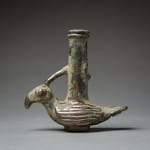Bactria-Margiana copper-alloy vessel in the shape of a bird, 1500 BCE - 1000 BCE
Copper-Alloy
9.1 x 8.6 cm
3 5/8 x 3 3/8 in
3 5/8 x 3 3/8 in
LO.1042
The Bactria–Margiana Archaeological Complex (BMAC), also known as the Oxus civilisation, is the modern archaeological designation for a Bronze Age civilisation in Central Asia, that flourished between ca. 2300 and...
The Bactria–Margiana Archaeological Complex (BMAC), also known as the Oxus civilisation, is the modern archaeological designation for a Bronze Age civilisation in Central Asia, that flourished between ca. 2300 and 1700 BC, in an area located in present-day northern Afghanistan, eastern Turkmenistan, southern Uzbekistan and western Tajikistan, centred on the upper Amu Darya (Oxus River). Bactria was the ancient Greek name for the area of Bactra (modern Balkh), in what is now northern Afghanistan, and Margiana was the ancient Greek name for the Persian satrapy of Margiana, the capital of which was Merv, in modern-day southeastern Turkmenistan.
Several sites of this civilisation were discovered and named by the Soviet archaeologist Viktor Sarianidi (1976). Sarianidi's excavations from the late 1970s onwards, revealed numerous monumental structures in sites fortified by impressive walls and gates.
The people of the BMAC culture were very proficient at working in a variety of metals including bronze, copper, silver and gold, as attested through the many metal artefacts found throughout the sites. They also practised the farming of wheat and barley. With their impressive material culture including monumental architecture, bronze tools, ceramics, and jewellery of semiprecious stones, the complex exhibits many of the hallmarks of civilisation.
The BMAC was contemporary with the European Bronze Age, and was characterised by monumental architecture, social complexity and extremely distinctive cultural artefacts. Pictographs on seals have been argued to indicate an independently-developed writing system.
It was one of many economic and social entities in the vicinity, and was a powerful country due to the exceptional fertility and wealth of its agricultural lands. This in turn gave rise to a complex and multifaceted set of societies with specialist craftsmen who produced luxury materials such as this for the ruling and aristocratic elites. Trade appears to have been important, as Bactrian artefacts appear all over the Persian Gulf as well as in the Iranian Plateau and the Indus Valley. For this reason, the area was fought over from deep prehistory until the Mediaeval period, by the armies of Asia Minor, Greece (Macedonia), India and the Arab States, amongst others.
During the 2nd millennium BC metallurgists in Bactria-Margiana were already fairly well-versed in the bronze casting process, both by mould and lost wax. As an integral part in their artistic production, bronze was used not only for ceremonial and functional axes, but also to create adornments, including pins, pendants and other accessories such as small cosmetic bottles. These bottles have been mostly excavated from burial contexts in Bactria-Margiana; the most interesting examples featuring three-dimensional sculptures of animals, just like the one here illustrated.
Several sites of this civilisation were discovered and named by the Soviet archaeologist Viktor Sarianidi (1976). Sarianidi's excavations from the late 1970s onwards, revealed numerous monumental structures in sites fortified by impressive walls and gates.
The people of the BMAC culture were very proficient at working in a variety of metals including bronze, copper, silver and gold, as attested through the many metal artefacts found throughout the sites. They also practised the farming of wheat and barley. With their impressive material culture including monumental architecture, bronze tools, ceramics, and jewellery of semiprecious stones, the complex exhibits many of the hallmarks of civilisation.
The BMAC was contemporary with the European Bronze Age, and was characterised by monumental architecture, social complexity and extremely distinctive cultural artefacts. Pictographs on seals have been argued to indicate an independently-developed writing system.
It was one of many economic and social entities in the vicinity, and was a powerful country due to the exceptional fertility and wealth of its agricultural lands. This in turn gave rise to a complex and multifaceted set of societies with specialist craftsmen who produced luxury materials such as this for the ruling and aristocratic elites. Trade appears to have been important, as Bactrian artefacts appear all over the Persian Gulf as well as in the Iranian Plateau and the Indus Valley. For this reason, the area was fought over from deep prehistory until the Mediaeval period, by the armies of Asia Minor, Greece (Macedonia), India and the Arab States, amongst others.
During the 2nd millennium BC metallurgists in Bactria-Margiana were already fairly well-versed in the bronze casting process, both by mould and lost wax. As an integral part in their artistic production, bronze was used not only for ceremonial and functional axes, but also to create adornments, including pins, pendants and other accessories such as small cosmetic bottles. These bottles have been mostly excavated from burial contexts in Bactria-Margiana; the most interesting examples featuring three-dimensional sculptures of animals, just like the one here illustrated.



